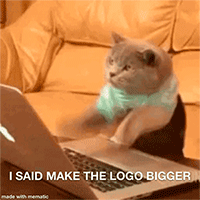
It’s frustrating when a style guide misses the essentials. Two-tone color palettes without a pop of color or a grounding neutral don’t provide enough flexibility for print materials or website design.

 A logo without a standalone tagline or glyph is difficult to use on social media.
A logo without a standalone tagline or glyph is difficult to use on social media.
Basically, an incomplete style guide limits your creativity when visually representing your brand. For marketers, writers and designers, a consistent yet flexible style guide helps them maintain brand positioning across all marketing materials and channels with…yes, style.
In this video, Design Consultant Robert Wasiluk talks through his must-have style guide elements that every organization needs to give their brands life and longevity. A flexible style guide keeps your brand fresh as color and font trends evolve.
If you already have a style guide and want to complete it with some of the elements that Robert talks about, we are happy to consult with you on complementary colors, alternative fonts or branding words and images.
Full Video Script
I’ve worked with a lot of branding style guides for graphic and web design. And it’s frustrating when elements are missing or incomplete.
Your branding style guide should offer flexibility for different design needs. But it should also ensure that your brand positioning is consistent for in-person and virtual business development.
For example, I often see limited color palettes in style guides. It’s always helpful as a designer to have two or more secondary color options that compliment your main brand colors. Don’t limit your color palette and try to avoid too many shades of the same color.
Contrast is important. But you also want to ground your brand with a neutral tone, which can be used effectively as a background color in websites.
Another style guide essential is alternative fonts. You may have fallen in love with a certain font for your logo, but it turns out that it doesn’t work for digital ad copy or your website. Offer a complimentary font as a simpler alternative for design flexibility and also a font that works across different platforms.
For example, we use Arial in our Power Point presentations so we know it will look consistent on a PC or a Mac.
Sometimes logos will have a mark or glyph that stands alone from the full logo. If you want to use that mark to symbolize your firm on social media or letterhead, then make sure that proper usage and options are spelled out in your style guide.
This includes reversing the glyph or how it should appear over background elements. Be sure that the glyph works at different sizes so it’s eligible no matter if it’s on a banner or in an email signature.
Another big essential is your brand positioning. What is your brand tone? Include images and phrases that describe your brand. Writers and designers appreciate having this guide to familiarize themselves with how you prefer to communicate your brand.
Style guides should be well designed to reflect your brand. Use your preferred font, colors and images to set the tone for all corporate branding.
Next: What do your brand colors mean?





